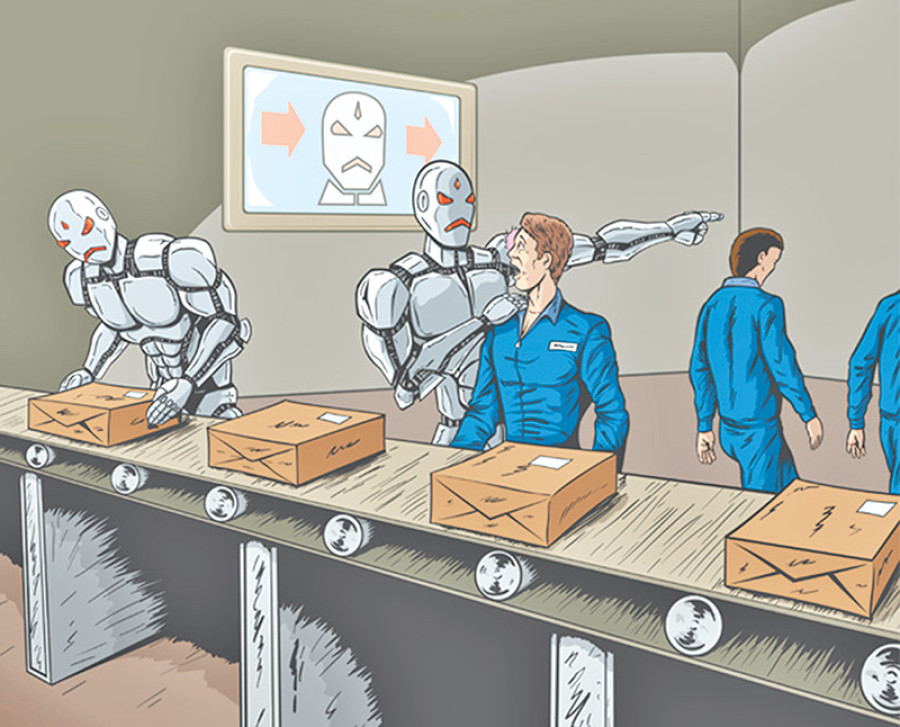Opinion
Will robots kill jobs?
As AI and robotics are changing the world, developing countries need their own strategies to cope up with automation
Yubaraj Guragain
The big debate of our times is if advancements in technology will have a dramatic impact on the labour market. In other words, will technology take over all our jobs? Be it simulating human actions like communicating or mimicking the human thought process, there is little computers and other devices cannot do. As artificial intelligence and robotics are changing the world, developing countries need their own strategies to keep up with automation and its impacts on the job market. The 49th annual meeting of the World Economic Forum in Davos and the World Development Report 2019 published by the World Bank accept the growing dominance of robotonomics indicating loss of low skill and routine types of jobs.
Sustainable development goals—the blueprint to achieve a better and more sustainable future for all—also focus on creating a healthy and well-educated workforce with the required knowledge and technical know-hows.
Technological unemployment, the substitution of human resources with technology, is real. When labour-saving machines are introduced into the productive process, a firm can lay off workers and produce the same amount of goods than before. As a result, some workers can lose their job. This uncertainty has severely affected an individual’s job security and as a corollary, their livelihood, too. In 2017, economists Carl Frey and Michael Osborne had concluded that more than 40 percent of jobs in the United States were at high risk of automation. Keeping in mind the decreasing rate of population coupled with companies’ desire to get more done in a less amount of time, developed countries have switched to automation.
As per the World Development Report, a total of 2.6 million industrial robots will be in operation by the end of 2019. This suggests that developing countries will have to face daunting challenges in the future. As doomsday prophecies start becoming more real, human resources will have to compete with robots, and labour-intensive industries will start becoming obsolete, while capital and technology intensive industries will come to dominate the economy.
The development report mentions that the world’s largest assembler of electronics, Foxconn Technology, of China, has introduced robots that are already cutting 30 percent of its workforce. Similarly, Sberbank-the largest bank in Russia—used ‘Robot Lawyers’, replacing 3,000 human employees and it is estimated that the number of human employees in the bank will be reduced to 1,000 by 2021. In 2011, the bank had 59,000 employees. It further mentions that low-skilled workers will be more vulnerable to the effects of automation, while jobs that require problem-solving, discursive reasoning, and socio-behavioural skills are not much threatened by the increasing use of technology in the workplace.
Regardless, governments need to adopt proactive measures and start investing in information technology education. Access to and the use of the internet is the new infrastructure. Nepal still has the most expensive internet facility in South Asia. There is still a long way to go in making it affordable and accessible to a wide section of the population. In the larger scheme of things, this means that our population will continue to be technologically illiterate who are unable to compete in techno-sensitive industries.
Developing countries as it is have high unemployment rates. As technology’s destruction of jobs primarily affects young people, it may come to be both-acutely economic and social at the same time.
Hence, in order to assure the employed future of its populace, the government needs to prepare its people to adapt to increasing automation. Introducing technology friendly education programmes and continually en-skilling, re-skilling and up-skilling facilities can contribute to this end. In fact, such initiatives must be at the centre of the government’s economic policies. No doubt, technological innovation plays a key role in economic growth, but the government needs to plan and prepare for the changes ahead.
Guragain is pursuing post-graduate studies in International Relations at Ritsumeikan University, Kyoto in Japan. He can be reached at [email protected]




 21.12°C Kathmandu
21.12°C Kathmandu










